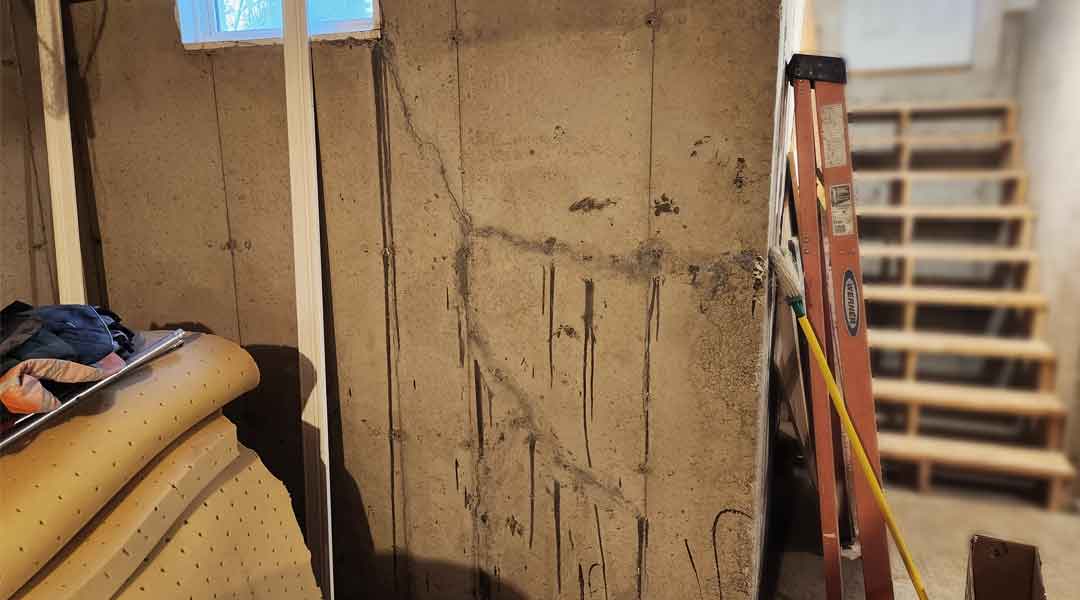
Don’t Let Basement Wall Cracks Lead to Bigger Problems
Noticed a crack in your basement wall? Don’t ignore it; what seems like a minor issue today can quickly lead to water intrusion, mold growth, radon gas infiltration, or even structural damage.
The good news? Most basement wall crack repair projects can be handled by homeowners without hiring a contractor. With the right tools and a bit of know-how, repairing foundation cracks becomes a manageable DIY task that saves both time and money.
For over 25 years, RadonSeal has helped thousands of homeowners perform professional-grade basement wall crack repair using easy-to-use, all-in-one kits. Whether you’re stopping water leaks, blocking radon, or prepping your basement for finishing, we’ve got a DIY solution that works like the pros, without the cost of hiring a specialist.
Why Basement Wall Cracks Happen
Cracks in basement walls, whether poured concrete or concrete block, are more common than you might think. While most cracks are harmless hairline fractures, some may signal underlying issues like soil pressure, poor drainage, or settling.
Here are the most common causes of foundation wall cracks:
-
Shrinkage During Curing – Too much water or rapid drying can create small cracks as the concrete hardens.
-
Expansive Clay Soils – These soils swell and shrink with moisture changes, pushing against the foundation.
-
Hydrostatic Pressure – Waterlogged soil puts force on the wall, especially after heavy rains.
-
Improper Backfilling or Poor Compaction – Can lead to uneven settling and foundation stress.
-
Freeze-Thaw Cycles – Repeated expansion and contraction of soil stresses the wall over time.
-
Gutter & Drainage Issues – Water pooling near the foundation increases pressure and risk of cracks.
Regardless of the cause, basement wall cracks can allow water, radon gas, moisture, and even pests into your home. That’s why early basement wall crack repair is key to protecting your foundation and indoor air quality.
Types of Basement Wall Cracks (and what they mean)
Identifying the direction and pattern of a basement wall crack is crucial, as it helps determine whether the crack is cosmetic, waterproofing-related, or a sign of structural damage. Here’s how to tell the difference:
⚡ Vertical & Diagonal Cracks
These are the most common cracks found in poured concrete foundation walls. They often occur within the first month after construction due to concrete shrinkage or minor foundation settling.
Where They Appear:
• Near the corners of the basement egress window openings.
• Along cold joints or form seams.
• Around utility penetrations and tie rods.
What They Mean:
• Typically non-structural.
• Can leak water, soil gases, and humidity.
• May widen slightly over time with continued settling.
• Ideal candidates for low-pressure polyurethane injection to permanently seal against leaks.
💡 PRO TIP: Even hairline cracks can allow water seepage or radon infiltration; don’t ignore them.
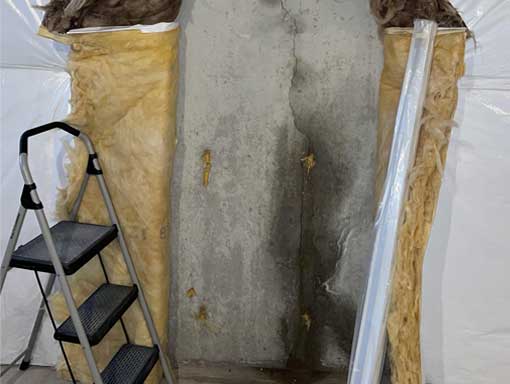
Vertical crack in a basement concrete wall with water causing dampness around the crack.
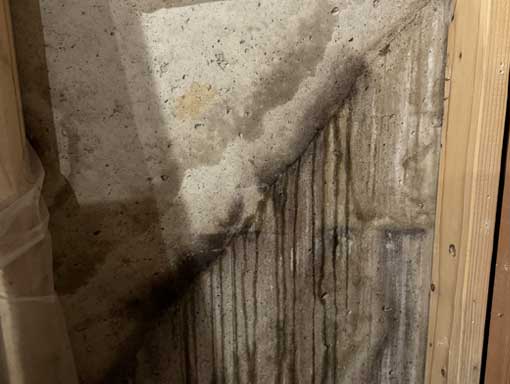
Diagonal crack in a poured concrete wall, with water seeping through due to external hydrostatic pressure.
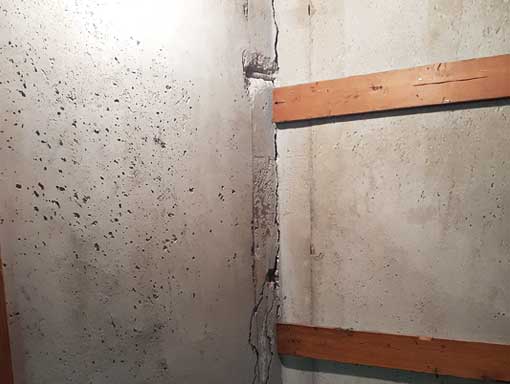
Corner crack in a concrete basement wall, showing separation and a potential path for water and radon.
⚡ Horizontal Cracks
A horizontal crack in a basement wall, especially through the midsection, can signal serious trouble. These cracks are often caused by hydrostatic pressure or expansive clay soils exerting force on the wall from the outside.
Warning Signs
• Crack is wider than 1/4 inch.
• Wall shows signs of bowing or inward deflection.
• Crack spans the full width of the wall.
What They May Indicate:
• Structural risk to the wall’s integrity.
• May require professional stabilization, such as carbon fiber straps or wall anchors.
• Should not be ignored or patched without a full assessment.
⚠️ Structural cracks often worsen over time. Monitor them for changes and consult a foundation specialist if in doubt.
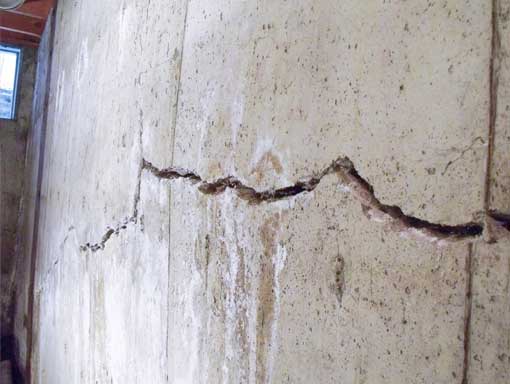
Horizontal crack in a poured concrete foundation wall, showing signs of structural stress and inward bowing.
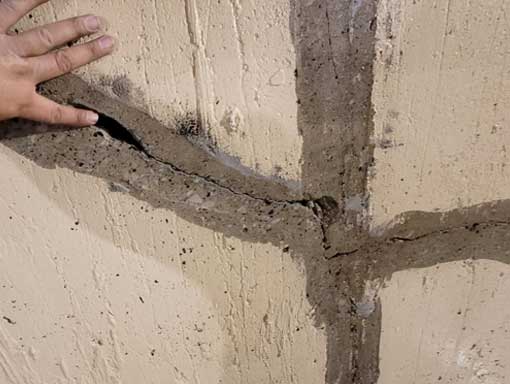
Wide horizontal cracks in basement walls should be evaluated by a licensed foundation engineer.
How to Fix Basement Wall Cracks on Your Own
Most minor basement wall cracks, especially if they’re dry, narrow, and not actively moving, can be permanently repaired from the inside without expensive excavation or hiring a contractor. Thanks to modern crack injection systems, DIY Basement Crack Repair is more effective and accessible than ever.
🔧 Polyurethane Crack Injection (Poured Concrete Walls)
For vertical or diagonal cracks in poured concrete foundation walls, low-pressure polyurethane injection is the preferred repair method. The liquid polyurethane expands inside the crack to form a flexible, closed-cell foam that fills the entire depth of the wall.
Benefits:
• Permanently fills and waterproofs the crack with polyurethane foam.
• Expands up to 35 times its original volume, reliably filling the full depth of the wall crack.
• Remains flexible, sealing against future movement.
• Blocks radon gas, groundwater, moisture, insects, rodents, and soil air infiltration.
• Bonds tightly to concrete, even if slightly damp.
💡 PRO TIP: Best used for hairline to cracks up to 1/2″ in poured concrete basement walls.
DIY Foundation Crack Repair Kits vs. Hiring a Pro
Not every basement crack requires hiring a contractor. In fact, most non-structural cracks, routinely those less than 1/4 inch wide, can be permanently sealed by homeowners using a foundation crack repair kit.
Hiring a crack repair specialist can be costly, with the average price to repair a 10-foot foundation crack approaching $1,000. The advantage of using a contractor is that the work typically includes a service warranty, protecting if the crack shifts or a small leak reappears, requiring the contractor to return and fix the issue at no additional cost.
By doing it yourself, you save the labor cost, and any future touch-up repairs are simple and inexpensive to perform.
When DIY Repair Makes Sense
RadonSeal offers both flexible polyurethane injection kits for waterproofing and structural epoxy injection kits for reinforcing load-bearing cracks. Our kits are designed for homeowners and include professional-grade materials and detailed instructions.
• The crack is vertical or diagonal (common).
•. It is a poured concrete wall crack, not a crack in a concrete block wall.
•. There are no significant signs of wall movement.
•. You want to stop water seepage, radon entry, or prevent further deterioration.
When to Call a Professional
Some cracks indicate more serious structural concerns and may require expert evaluation. You should consider hiring a foundation repair contractor if:
• The wall shows signs of bowing, displacement, or movement.
• The crack is in a block foundation and involves widespread damage.
• The repair involves multiple wide cracks or structural stabilization.
In these cases, professionals may use wall anchors, piering, or a foundation rebuilt to restore the integrity of the structure.
Final Thoughts: Fix Basement Wall Cracks Before They Get Worse
Basement wall cracks are more than just cosmetic; they’re direct pathways for water intrusion, radon gas, humidity, and even pests. Left untreated, they can lead to mold, structural deterioration, and costly repairs down the road.
The good news? Most wall cracks can be fixed permanently with a DIY injection kit. Whether you’re sealing a hairline crack or reinforcing a larger horizontal crack, RadonSeal has a proven solution designed for homeowners.
Why Choose RadonSeal Repair Kits?
•. Professional-grade materials, no contractor required.
•. Polyurethane and epoxy options for waterproofing and structural strength.
•. Kits tailored to poured concrete walls.
•. Backed by 25+ years of field-proven performance.
DIY Crack Repair Kits That Work
You don’t need to be a contractor to fix basement wall cracks; just the right tools, materials, and a little guidance. RadonSeal’s complete DIY & PRO Crack Repair Kits are designed to make basement wall and floor repairs fast, permanent, and hassle-free, even for first-time homeowners and professionals alike.